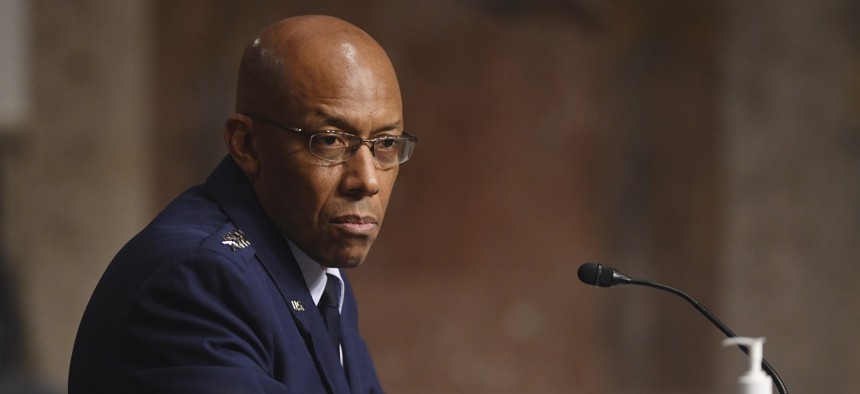
Gen. Charles Q. Brown, Jr. testifies on his nomination to be Air Force Chief of Staff before the Senate Armed Services committee May 7, 2020. Getty Images
At House Hearing, Defense Appropriators Discuss Everything But the Budget
The Biden administration has yet to submit a 2022 budget request, limiting Congress’ ability to oversee defense spending.
When U.S. Air Force and Space Force leaders testified before a House appropriations subcommittee on Friday on their 2022 budget requests, only a single question about actual program costs was asked.
The lawmakers didn’t probe more because there’s still no official budget request from the Biden administration to question. Instead, the defense appropriations subcommittee focused on policy — which is more often the purview of their House Armed Services Committee colleagues.
In the two-hour hearing, Air Force acting secretary John Roth, U.S. Space Force Chief of Space Operations Gen. John Raymond, and Air Force Chief of Staff Gen. CQ Brown fielded questions about the Space Force’s role in detecting China’s tumbling Long March 5B rocket and the need to remain competitive with China.
Members asked the Air Force leaders whether they still faced pilot shortages (they do, but the gaps shrank somewhat during the pandemic, thanks in part to moves like sending prospective helicopter pilots straight to rotary-wing school). They also asked whether the service’s pending study on the right mix of tactical air fighters will be reflected in the service’s 2022 spending request. The study is expected to inform what existing aircraft the service might seek to retire and what mix of additional 4th- and 5th-generation fighters it may want to buy. Brown said the study would shape his decisions, but did not say whether it would arrive in time for the 2022 request.
The Ground Based Strategic Deterrent replacement for the Minuteman III came up, but not its cost, which the Defense Department said in October could eventually total $264 billion.
The lone spending question was about the Air Force’s efforts to re-wing its A-10 Thunderbolt II ground-attack aircraft, better known as the Warthog. Members wanted to know whether the program was on track and how much the Air Force would be requesting in 2022. Brown said they could expect a request in line with those of recent years.
At the beginning of the hearing, Chairwoman Rep. Betty McCollum, D-Minn., noted the absence of details and asked the services to provide actual numbers as soon as possible.
“I acknowledge that we are holding this hearing before the release of the full budget request, and we understand that this may limit your ability to answer certain questions,” McCollum said. “However, given the tight timeframe we have to write the bill, I ask that you be prepared to respond to members on any specific budget question they ask today immediately, and also to the full committee at the same time, after the request is submitted.”
Congress has until Sept. 30 to pass a defense budget on time and avoid another continuing resolution, a stopgap measure that freezes spending at the previous year’s levels. The combined Air Force and Space Force budget in 2021 was $169 billion.
“It's extremely difficult for Congress to do its due diligence and oversight without a budget,” said Mandy Smithberger, director of the Straus Military Reform Project at the Project On Government Oversight. “Some delays are expected with any new administration, and it sounds like transition issues between the Trump and Biden administrations likely exacerbated those problems. But the end result is still the same: Congress doesn't have enough time to review the request.”
And there can be deadly consequences to late budgets. A December independent commission noted that aviation accidents since 2013 have killed 224 military pilots and aircrew and destroyed $11.6 billion in aircraft, and found that the repeat continuing resolutions were a large contributing factor. The continuing resolutions “compromise safety, and place lives at risk,” the commission found.




